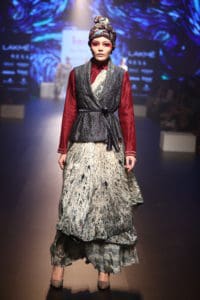Lakme Fashion Week has given five fashion designers a chance of their lifetime. But it is up to them to create something that sets them apart
Fashion is a fairly new business in India, yet emerging markets have ensured robust platforms for it to present new talent in the country. The cross-pollination of textile heritage and international sensibilities have enabled India with its own niche design that it can call its own. At the recently concluded Lakme Fashion Week in Mumbai, five fashion designers representing India’s GenNext, proved yet again the possibilities that are available in India to be explored by an apparel engineer.
The competition happens every six months giving a chance to emerging fashion designers to showcase their work at the reputed platform, apart from the mentoring by top industry professionals. Having said that, it is interesting to note what makes these individuals choose a line of work which embodies them.
“In the initial years, fashion, in my eyes was never something I would be interested in”, says Yadvi Agarwal of Yavi, one of the shortlisted designers who presented as part of Lakme Fashion Week’s gen-next category. Someone who studied science in senior school figured only in later years that she wanted to do something in the creative arts. With work that uses inspiration from various art movements, she settled with a full scholarship at Pearl Academy in Delhi and further went on to study textiles at National Institute of Design.
Her time at NID was spent experimenting with textiles where she honed her design language which is more instinctive and playful. “My karigars who developed my block printed textiles were apprehensive about how I wanted a certain design, which was more like abstract art”, says Yadvi who believes in an organic approach to develop her collection.

As someone who started her business with the international market, she recalls her first collection exhibited at trade shows in Europe that didn’t go too well. She accepts it was a result of making a calculated collection using all possible tools that ensure good business in certain markets, “The response to my second exhibition was a surprise, as I was much more free and intuitive when I created them.”
The learning here, she thinks, is to follow one’s own gut, and to this date, she has no particular framework according to which she designs her clothes. “The experience gave me the confidence to not blindly follow the rules. It is a creative business at the end of the day and only honesty within one’s craft will work”, says Yadvi. Textiles are part of the industrial design and it is her firm belief that the idea of design is to solve a problem.
For Shweta Gupta of SWGT, another presenting designer, fashion is always something she wanted to pursue, being creatively inclined since childhood. She recalls the memory of winning a silver medal at Shankar’s International Art competition during her school days. “I could not attend the prize distribution ceremony in Delhi as I lived in Almora, but I remember telling the press that I wanted to become a fashion designer.”
Shweta who has worked with the best designers in the country before she started her own label, is patient as ever, even when she knew she wanted her own venture. “I am not a textile designer by education, but I am aware of the possibilities we have in India with textiles. With that, I want to challenge myself.”
The textile for her GenNext collection is woven by weavers in Chanderi. She presses on the fact that Chanderi, a textile that is a mix of cotton and silk yarn has a geographical indication and anything that’s woven in a certain location in Madhya Pradesh will be called so. She is currently working with ten families in the village who have looms in their homes and the men & women weave a small chunk of the fabric every day irrespective of anyone waiting to buy it. “It is their culture, even kids want to weave a small bit of it”, she adds.
As all the textile is hand woven, which is a time taking process, it is going to be demanding for her to produce in big numbers. However, she is positive and believes that the right equation between her and her karigars can produce for a larger market. Her collection uses as inspiration, the terrain in Harsil, a village in Uttarakhand. Handloom, for her, has an emotional value and her motive is to reach the right audience for her clothes.
Travel fanatics and life partners Neelanjan and Kanika’s label Jajaabor, is another presenting label who derive their inspiration from their travels. Jajaabor means a nomad in Assamese. Neelanjan tells us the brand caters to the growing domestic market. “The Indian woman is used to wearing a certain kind of clothing. Jajaabor reinvents the classic styles for them, as something they can wear on their travels.”
As we ask about the duos life, apart from work, Neelanjan assures that they live a perfectly normal life. Work for them takes up most of their time, as it does for many other professionals. He shares with us about their normal lives and his experience of working in the fashion industry. “This movie Fashion by Madhur Bhandarkar gives a false idea about how the industry works. See this is what happens when an outsider makes a film on fashion.”

According to him, fashion is rather a difficult place to be in as it is still an unorganized industry in India. “I have worked at Tarun Tahiliani and it was pretty balanced there, but I do hear stories of tough working environments”, tells Neelanjan adding that the adrenaline is worth all the Sundays and national holidays he has spent working. “But at the end of the day, we all want some time for ourselves”, adds the co-designer. He believes there is no dearth of business in the country if one can tap the markets well.
There is a new selection of designers every season that defines the GenNext for India, and for them, it is their individual dreams and experiences that guide to create their own path. The fashion week, which gives them enough publicity is only one side of the story. Getting an entire collection designed, marketed and produced is a fashion designer’s evolvement.





